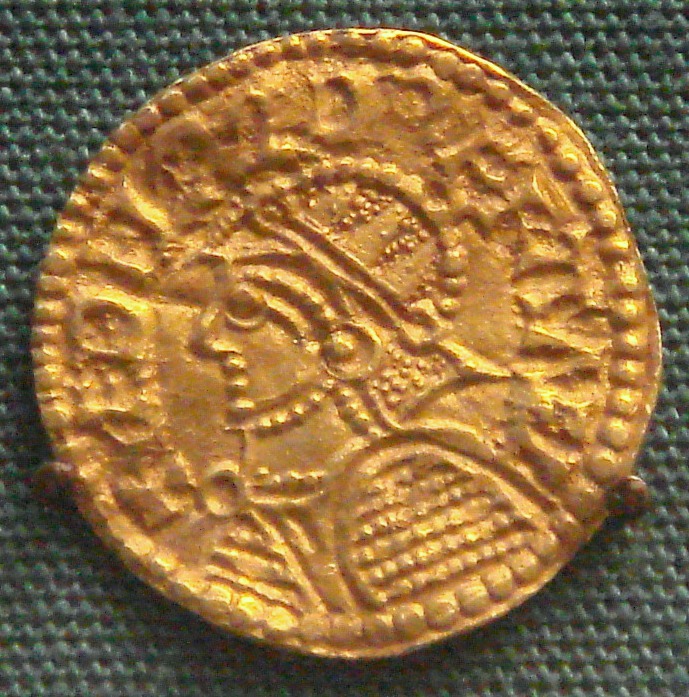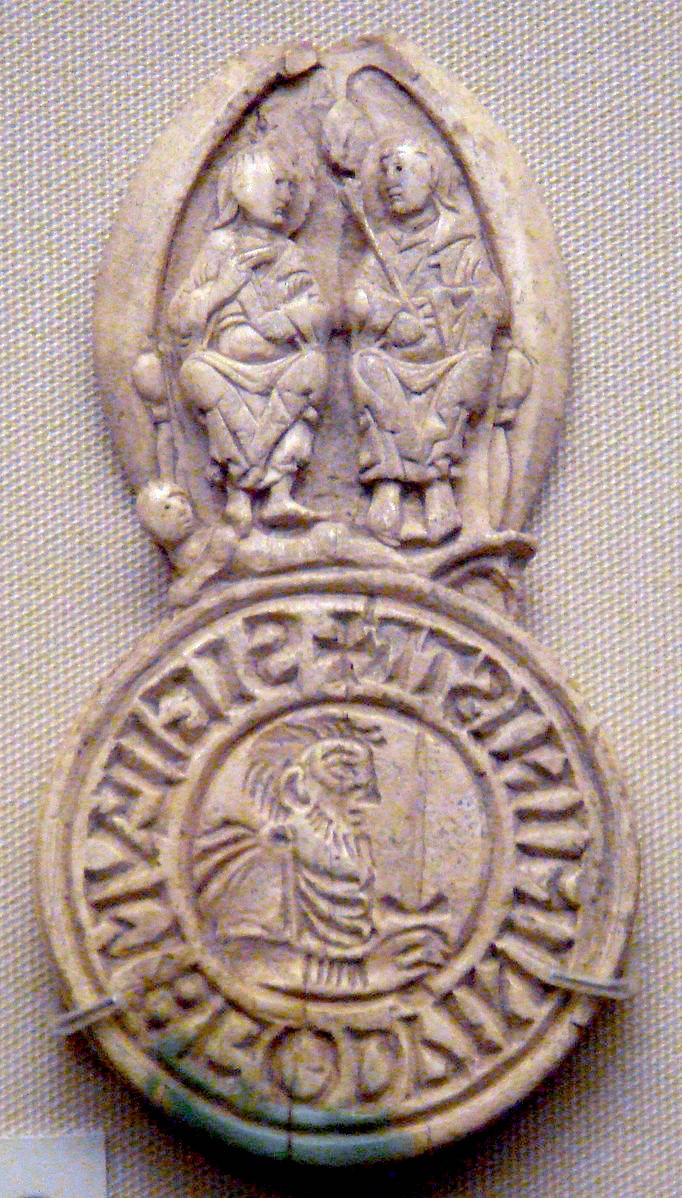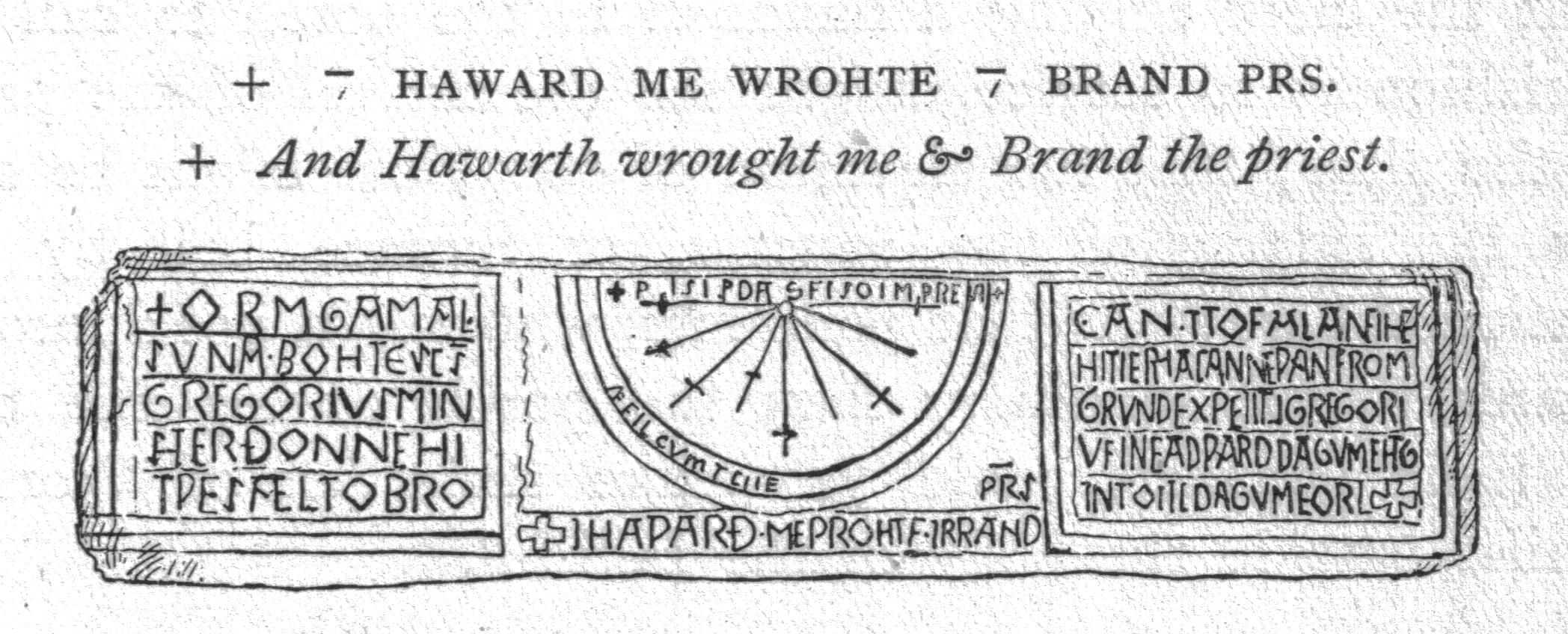|
House Of Godwin
The House of Godwin was an Anglo-Saxon family and one of the leading noble families in England during the last 50 years before the Norman Conquest. Its most famous member was Harold Godwinson, king of England for nine months in 1066. The founder of the family's greatness, Earl Godwin, was raised from comparative obscurity by king Cnut and given the earldom of Wessex around the year 1020. He retained his position during the reigns of Cnut's sons Harold Harefoot and Harthacnut, and consolidated it when king Edward the Confessor conferred earldoms on Sweyn and Harold, Godwin's two eldest sons by his Danish wife, Gytha. The family survived a short-lived attempt by the king to exile them. After Godwin's death his sons held the earldoms of Wessex, East Anglia, and later Northumbria; Harold in particular became the most powerful man in England, eclipsing the power of the king. When Edward the Confessor died childless in 1066 he was succeeded by Harold Godwinson. Harold gain ... [...More Info...] [...Related Items...] OR: [Wikipedia] [Google] [Baidu] |
Royal House
A dynasty is a sequence of rulers from the same family,''Oxford English Dictionary'', "dynasty, ''n''." Oxford University Press (Oxford), 1897. usually in the context of a monarchy, monarchical system, but sometimes also appearing in republics. A dynasty may also be referred to as a "house", "family" or "clan", among others. Historians periodization, periodize the histories of many states and civilizations, such as Ancient Iran (3200 - 539 BC), Ancient Egypt (3100 – 30 BC) and History of China#Ancient China, Ancient and Imperial China (2070 BC – AD 1912), using a framework of successive dynasties. As such, the term "dynasty" may be used to delimit the era during which a family reigned. Before the 18th century, most dynasties throughout the world have traditionally been reckoned patrilineality, patrilineally, such as those that follow the Franks, Frankish Salic law. In polities where it was permitted, succession through a daughter usually established a new dynasty in ... [...More Info...] [...Related Items...] OR: [Wikipedia] [Google] [Baidu] |
Edward The Confessor
Edward the Confessor ; la, Eduardus Confessor , ; ( 1003 – 5 January 1066) was one of the last Anglo-Saxon English kings. Usually considered the last king of the House of Wessex, he ruled from 1042 to 1066. Edward was the son of Æthelred the Unready and Emma of Normandy. He succeeded Cnut the Great's son – and his own half-brother – Harthacnut. He restored the rule of the House of Wessex after the period of Danish rule since Cnut conquered England in 1016. When Edward died in 1066, he was succeeded by his wife's brother Harold Godwinson, who was defeated and killed in the same year by the Normans under William the Conqueror at the Battle of Hastings. Edward's young great-nephew Edgar the Ætheling of the House of Wessex was proclaimed king after the Battle of Hastings in 1066 but was never crowned and was peacefully deposed after about eight weeks. Historians disagree about Edward's fairly long 24-year reign. His nickname reflects the traditional image ... [...More Info...] [...Related Items...] OR: [Wikipedia] [Google] [Baidu] |
Æthelmær The Stout
Æthelmær the Stout or Æthelmær the Fat (died 1015) a leading thegn from the 980s, ''discðegn'' (dish-bearer or seneschal) to King Æthelred the Unready, and briefly ealdorman of the Western Provinces in 1013. He was the founder of Cerne Abbey and Eynsham Abbey, and a patron of the leading scholar, Ælfric of Eynsham. He was the son of Æthelweard the historian, and descended from King Æthelred I. Career Together with his father, he was a patron of the homilist Ælfric of Eynsham. In 987 Æthelmær founded or re-founded Cerne Abbey in Dorset, and in 1005 founded Eynsham Abbey in Oxfordshire, where he made Ælfric its first abbot, along with Priory of Bruton in Somerset. Ælfric dedicated his ''Lives of the Saints'' to Æthelmær. In a charter of 993 in which King Æthelred II laments his past misrule, which had resulted “partly on account of the ignorance of my youth, and partly on account of the abhorrent greed of certain of those men who ought to administer to my intere ... [...More Info...] [...Related Items...] OR: [Wikipedia] [Google] [Baidu] |
New Minster, Winchester
The New Minster in Winchester was a royal Benedictine abbey founded in 901 in Winchester in the English county of Hampshire. Alfred the Great had intended to build the monastery, but only got around to buying the land. His son, Edward the Elder, finished the project according to Alfred's wishes, with the help of Saint Grimbald who became its first abbot. It stood so close to the Old Minster that the voices of the two choirs merged with chaotic results. The body of King Alfred was transferred to the New Minster, Saint Grimbald joined him and it was also given the body of the Breton Saint Judoc (Saint Josse), making it an important pilgrimage centre. It became a Benedictine house in 963. According to John of Worcester, in 972 King Edgar "ordered the church of the New Minster, begun by his father King Edmund, but completed by himself, to be solemnly dedicated". It is not known what parts of the church were rebuilt. Queen Emma added the head of Saint Valentine in 1041. With the ... [...More Info...] [...Related Items...] OR: [Wikipedia] [Google] [Baidu] |
Ælfwig (abbot)
Ælfwig (died 1066), was the abbot of New Minster, the uncle of Harold, and was probably the brother of Earl Godwine Godwin of Wessex ( ang, Godwine; – 15 April 1053) was an English nobleman who became one of the most powerful earls in England under the Danish king Cnut the Great (King of England from 1016 to 1035) and his successors. Cnut made Godwin the .... Ælfwig was made abbot in 1063. When Harold marched to meet the Normans, Ælfwig joined him with twelve of his monks, wearing coats of mail over their monastic garb, and with twenty armed men. He and his monks fell fighting at Senlac. After the battle their bodies were recognised by the habit of their order, which was seen beneath their armour. The Conqueror punished the convent severely for the part which it had taken in resisting his invasion. References * External links * 1066 deaths English abbots 11th-century English clergy Year of birth unknown {{England-reli-bio-stub ... [...More Info...] [...Related Items...] OR: [Wikipedia] [Google] [Baidu] |
Æthelred The Unready
Æthelred II ( ang, Æþelræd, ;Different spellings of this king’s name most commonly found in modern texts are "Ethelred" and "Æthelred" (or "Aethelred"), the latter being closer to the original Old English form . Compare the modern dialect word ., non, Aðalráðr 966 – 23 April 1016), known as Æthelred the Unready, was King of the English from 978 to 1013 and again from 1014 until his death in 1016. His epithet does not derive from the modern word " unready", but rather from the Old English meaning "poorly advised"; it is a pun on his name, which means "well advised". Æthelred was the son of King Edgar the Peaceful and Queen Ælfthryth. He came to the throne at about the age of 12, following the assassination of his older half-brother, King Edward the Martyr. The chief problem of Æthelred's reign was conflict with the Danes. After several decades of relative peace, Danish raids on English territory began again in earnest in the 980s, becoming marked ... [...More Info...] [...Related Items...] OR: [Wikipedia] [Google] [Baidu] |
Thegn
In Anglo-Saxon England, thegns were aristocratic landowners of the second rank, below the ealdormen who governed large areas of England. The term was also used in early medieval Scandinavia for a class of retainers. In medieval Scotland, there were local officials known as thanes. Etymology The Old English (, "man, attendant, retainer") is cognate with Old High German and Old Norse ("thane, franklin, freeman, man"). The thegn had a military significance, and its usual Latin translation was , meaning soldier, although was often used. ''An Anglo-Saxon Dictionary'' describes a thegn as "one engaged in a king's or a queen's service, whether in the household or in the country". It adds: "the word ... seems gradually to acquire a technical meaning, ... denoting a class, containing several degrees", but what remained consistent throughout was its association with military service. Origins The precursor of thegn was the ''gesith'', the companion of the king or great lord, ... [...More Info...] [...Related Items...] OR: [Wikipedia] [Google] [Baidu] |
Wulfnoth Cild
Wulfnoth Cild (; died 1014) was a South Saxon thegn who is regarded by historians as the probable father of Godwin, Earl of Wessex, and thus the grandfather of King Harold II. Biography It is known that Godwin's father was called Wulfnoth, and in the view of Frank Barlow, the Godwin family's massive estates in Sussex are indisputable evidence that the Wulfnoth in question was the South Saxon thegn. In 1008, King Æthelred the Unready ordered the construction of a fleet, and the following year 300 ships assembled at Sandwich, Kent to meet a threatened Viking invasion. There Brihtric, brother of Eadric Streona, brought unknown charges against Wulfnoth before the king, unjustly according to John of Worcester. Wulfnoth then fled with twenty ships and ravaged the south coast. Brihtric followed with eighty, but his fleet was driven ashore by a storm and burnt by Wulfnoth. After the loss of a third of the fleet the remaining ships were withdrawn to London, and the Vikings were able ... [...More Info...] [...Related Items...] OR: [Wikipedia] [Google] [Baidu] |
Northern Europe
The northern region of Europe has several definitions. A restrictive definition may describe Northern Europe as being roughly north of the southern coast of the Baltic Sea, which is about 54th parallel north, 54°N, or may be based on other geographical factors such as climate and ecology. Climate The climate is mainly Oceanic climate (Cfb), Humid continental climate (Dfb), Subarctic climate (Dfc and Dsc) and Tundra (ET). Geography Northern Europe might be defined roughly to include some or all of the following areas: British Isles, Fennoscandia, the peninsula of Jutland, the Baltic region, Baltic plain that lies to the east and the many islands that lie offshore from mainland Northern Europe and the main European continent. In some cases, Greenland is also included, although it is only politically European, comprising part of the Kingdom of Denmark, and not considered to be geographically in Europe. The area is partly mountainous, including the northern volcanic islands ... [...More Info...] [...Related Items...] OR: [Wikipedia] [Google] [Baidu] |
Battle Of Hastings
The Battle of Hastings nrf, Batâle dé Hastings was fought on 14 October 1066 between the Norman-French army of William the Conqueror, William, the Duke of Normandy, and an English army under the Anglo-Saxons, Anglo-Saxon King Harold Godwinson, beginning the Norman Conquest of England. It took place approximately northwest of Hastings, close to the present-day town of Battle, East Sussex, and was a decisive Normans, Norman victory. The background to the battle was the death of the childless King Edward the Confessor in January 1066, which set up a succession struggle between several claimants to his throne. Harold was crowned king shortly after Edward's death, but faced invasions by William, his own brother Tostig Godwinson, Tostig, and the Norwegian King Harald Hardrada (Harold III of Norway). Hardrada and Tostig defeated a hastily gathered army of Englishmen at the Battle of Fulford on 20 September 1066, and were in turn defeated by Harold at the Battle of Stamford Brid ... [...More Info...] [...Related Items...] OR: [Wikipedia] [Google] [Baidu] |
Battle Of Stamford Bridge
The Battle of Stamford Bridge ( ang, Gefeoht æt Stanfordbrycge) took place at the village of Stamford Bridge, East Riding of Yorkshire, in England, on 25 September 1066, between an English army under King Harold Godwinson and an invading Norwegian force led by King Harald Hardrada and the English king's brother Tostig Godwinson. After a bloody battle, both Hardrada and Tostig, along with most of the Norwegians, were killed. Although Harold Godwinson repelled the Norwegian invaders, his army was defeated by the Normans at Hastings less than three weeks later. The battle has traditionally been presented as symbolising the end of the Viking Age, although major Scandinavian campaigns in Britain and Ireland occurred in the following decades, such as those of King Sweyn Estrithson of Denmark in 1069–1070 and King Magnus Barefoot of Norway in 1098 and 1102–1103. Background The death of King Edward the Confessor of England in January 1066 had triggered a succession struggle ... [...More Info...] [...Related Items...] OR: [Wikipedia] [Google] [Baidu] |
Tostig Godwinson
Tostig Godwinson ( 102925 September 1066) was an Anglo-Saxon Earl of Northumbria and brother of King Harold Godwinson. After being exiled by his brother, Tostig supported the Norwegian king Harald Hardrada's invasion of England, and was killed alongside Hardrada at the Battle of Stamford Bridge in 1066. Background Tostig was the third son of the Anglo-Saxon nobleman Godwin, Earl of Wessex and Gytha Thorkelsdóttir, the daughter of Danish chieftain Thorgil Sprakling. In 1051, he married Judith of Flanders, the only child of Baldwin IV, Count of Flanders by his second wife, Eleanor of Normandy. In 1086, the Domesday Book recorded twenty-six vills or townships as being held by Earl Tostig, forming the Manor of Hougun which now forms part of the county of Cumbria in north-west England. Earl of Northumbria In the 19th century, the antiquarian Edward Augustus Freeman posited a hypothesis claiming that Edward the Confessor, King of England, was pursuing a policy of " Normani ... [...More Info...] [...Related Items...] OR: [Wikipedia] [Google] [Baidu] |







.jpg)
